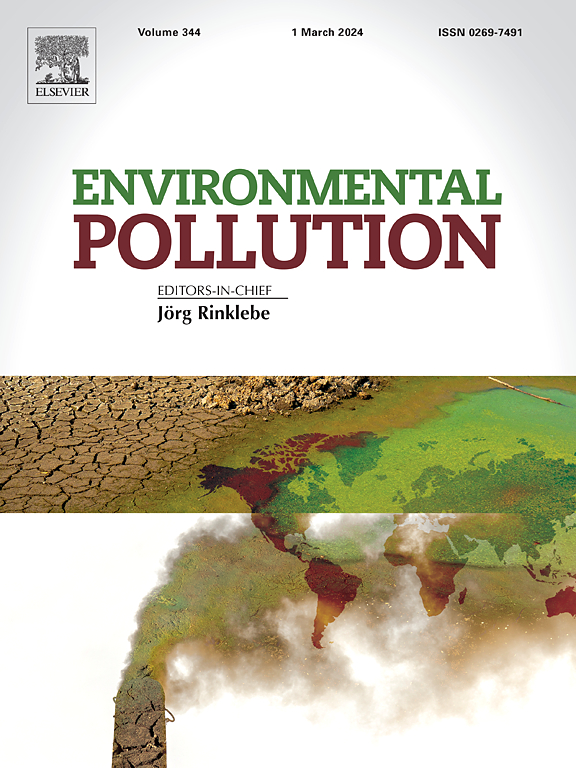Risks of biodegradable films: The time-lagged release of phthalic acid esters and organophosphates esters under realistic agricultural environments
IF 7.6
2区 环境科学与生态学
Q1 ENVIRONMENTAL SCIENCES
引用次数: 0
Abstract
Agricultural plastic films, while boosting crop productivity, may pose significant environmental risks due to additive release during crack degradation. Phthalic acid esters (PAEs) and organophosphate esters (OPEs), widely used as plasticizers and flame retardants respectively, represent two additive categories of the greatest environmental concern due to their persistence and endocrine-disrupting properties. This study systematically investigated the dynamic release of PAEs and OPEs from polyethylene (PE) and biodegradable poly (butylene adipate-co-terephthalate)/polylactic acid (PBAT/PLA)-based films under four simulated agricultural conditions: Natural conditions (NC), UV irradiation (UV), high temperature (HT), and flooding (FC). Uncultivated soil exhibited Σ8PAEs and Σ7OPEs approximately of 1317.5 ng/g and 1931.1 ng/g, respectively. During a 360 d incubation period, the contents of PAEs in soil surged during a short-term period, which may link to the desorption of adsorbed contaminant. Biodegradable films released higher PAEs concentrations than PE films, with secondary contamination peaks emerging 180–360 d post-incubation. Scanning electron microscopy (SEM) observations revealed that structural degradation (e.g., cracks/holes) during early degradation (0–180 d) unexpectedly amplified additive leaching in later stages, contrasting with assumptions of reduced contamination risks over time. UV irradiation had a photo-degradation effect on PAEs further accelerated the release of pollutants by 25–40 %, while high temperature and flooding conditions showed limited promoting effects along with NC conditions. These findings highlight the need for additive-free formulations and environment-specific mulch management policies to mitigate soil contamination risks.

生物可降解薄膜的风险:现实农业环境下邻苯二甲酸酯和有机磷酸酯的滞后释放
农用塑料薄膜在提高作物产量的同时,由于裂缝降解过程中添加剂的释放,可能会造成重大的环境风险。邻苯二甲酸酯(PAEs)和有机磷酸酯(OPEs)分别被广泛用作增塑剂和阻燃剂,由于它们的持久性和内分泌干扰特性,它们是最受环境关注的两类添加剂。本研究系统研究了聚乙烯(PE)和可生物降解聚己二酸丁二酯/聚乳酸(PBAT/PLA)基薄膜在自然条件(NC)、紫外线照射(UV)、高温(HT)和水浸(FC)四种模拟农业条件下PAEs和OPEs的动态释放。未开垦土壤的Σ8PAEs和Σ7OPEs分别约为1317.5 ng/g和1931.1 ng/g。在360 d的培养期内,土壤中PAEs的含量在短期内急剧上升,这可能与吸附污染物的解吸有关。生物降解膜的PAEs浓度高于PE膜,在培养后180 ~ 360 d出现二次污染峰值。扫描电镜(SEM)观察显示,早期降解(0-180 d)期间的结构降解(如裂缝/孔洞)意外地放大了后期阶段的添加剂浸出,这与随着时间的推移污染风险降低的假设形成了对比。紫外线照射对PAEs的光降解作用进一步加速了污染物的释放25-40%,而高温和淹水条件以及NC条件的促进作用有限。这些发现强调了需要无添加剂配方和环境特定的覆盖管理政策来减轻土壤污染风险。
本文章由计算机程序翻译,如有差异,请以英文原文为准。
求助全文
约1分钟内获得全文
求助全文
来源期刊

Environmental Pollution
环境科学-环境科学
CiteScore
16.00
自引率
6.70%
发文量
2082
审稿时长
2.9 months
期刊介绍:
Environmental Pollution is an international peer-reviewed journal that publishes high-quality research papers and review articles covering all aspects of environmental pollution and its impacts on ecosystems and human health.
Subject areas include, but are not limited to:
• Sources and occurrences of pollutants that are clearly defined and measured in environmental compartments, food and food-related items, and human bodies;
• Interlinks between contaminant exposure and biological, ecological, and human health effects, including those of climate change;
• Contaminants of emerging concerns (including but not limited to antibiotic resistant microorganisms or genes, microplastics/nanoplastics, electronic wastes, light, and noise) and/or their biological, ecological, or human health effects;
• Laboratory and field studies on the remediation/mitigation of environmental pollution via new techniques and with clear links to biological, ecological, or human health effects;
• Modeling of pollution processes, patterns, or trends that is of clear environmental and/or human health interest;
• New techniques that measure and examine environmental occurrences, transport, behavior, and effects of pollutants within the environment or the laboratory, provided that they can be clearly used to address problems within regional or global environmental compartments.
 求助内容:
求助内容: 应助结果提醒方式:
应助结果提醒方式:


